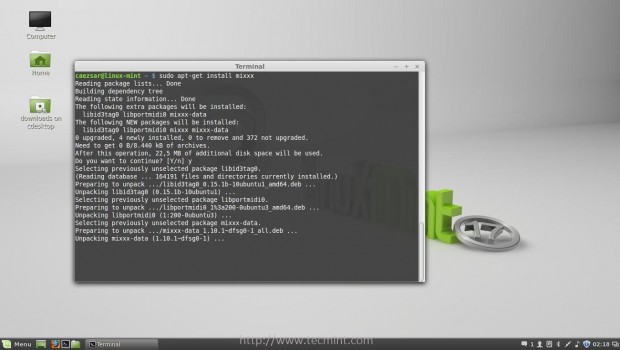How To Minimize Mixxx
If you need to reset your password,.Having a problem logging in? Linux from scratch live cd download.
Loading a controller preset ¶. Connect your controller(s) to your computer. Go to Preferences ‣ Controllers. Select your device from the list of available devices on the left, and the right pane will change. Activate the Enabled checkbox. Select the mapping for your controller from the. May 03, 2013 The previous tutorial concerning SHOUTcast server, just covered the basic server setup on CentOS 7 Linux distribution, without any live media streaming. This guide is not addressed for advanced Linux users and will guide you through the process of how you can use one of the most popular music player on Windows platforms, Winamp, to broadcast audio media online from remote points.
* Manufacturer's product page
* Manufacturer's support and downloads page
* Forum thread
Sound card setup
This controller has built-in 4 channel output sound card, with MASTER output (RCA and 3.5mm jack) and HEADPHONE output (6.35mm jack).

* Open Preferences > Sound Hardware
* Select the Output tab
* From the Master drop-down menu, select the audio interface, then Channels 1-2
* From the Headphones drop-down menu, select the audio interface, then Channels 3-4
* Click Apply to save the changes.
Please refer to the user manual for more details about theaudio configuration in Mixxx and learning how to set your levels properly.
Mapping description
Save both MIDI and script files to your user controller mapping folder, then load the preset as described in the user manual
Seats are limited.You will need access to the RX 7 Standard software. Online rx izotops certification. IZotope will provide temp software if yout don’t have a copy.
Original mapping by toxicshadow, updated by DJ Phatso (March 2019)
__Changes to v1.1:__
* SCRATCH button: now enable/disable the scratch function on the jogwheel (Default: ON)
* REC button: maximize/minimize Library view
* MAGIC button: AutoDJ On/Off
* BROWSER: Corrected the browser encoder assignment to new Library control(ScrollVertical), and added encoder button to MOVE FOCUS
* FX: Modified mapping and script to reflect changes to the new effects framework (see updated description for more details)
* Headphone: Added Headphone CUE/MIX to SHIFT+PFL buttons
Decks:
Vinyl = Scratch On/Off (Default: ON)
REC Button = Maximize/minimize library
MAGIC = AutoDJ On/Off
CUE/MIX:
SHIFT + PFL button (Deck A/B respectively) = Switch monitor cue mix to 50%.
PADS - Hot Cue Mode:
PAD 1-8 = Set and trigger Hot Cue 1-8
SHIFT + Pad = Delete Hot Cue 1-8.
Encoder = Deck Gain
PADS - FX Mode:
PAD 1-3 on/off
SHIFT + Pad = FX 1-3 Select
PAD 4 = FX Rack 1/2 On/Off (Deck A/B respectively)
PAD 5 = FX Rack 1/2 - On/Off to Master
PAD 8 = FX Rack 1/2 - Headphone enabled
Encoder = FX rack dry/Wet
SHIFT + Encoder = Filter
PADS - Sample:
PAD 1-4 = Set and trigger Hot Cue 1-4 (Sampler 1- Deck A/ Sampler 3- Deck B )
PAD 5-8 = Set and trigger Hot Cue 1-4 (Sampler 2- Deck A/ Sampler 4- Deck B)
SHIFT + Pad = Delete Hot Cue.
Encoder = Sampler 1 & 3 Gain
SHIFT + Encoder = Sampler 2 & 4 Gain
PADS - Loop Mode:
PAD 1-8 = Beatloop 1/8, 1/4, 1/2, 1, 2, 4, 8, 16 beats
Encoder = Deck Gain
Other controls as labeled.

Mixxx is free DJ software forWindows, macOS and Linux. It’s easy to use, even if you’ve never DJed.Mixxx offers a variety of features to help beginners get started and helpexperienced DJs get creative:
beat, tempo, and musical key detection
master sync
hotcues
looping
4 decks
effects
You can use Mixxx to perform with MIDI and HID controllers,CD players, vinyl turntables or even just your computer’s keyboard and mouse.
How To Minimize Mistakes At Work
Table of Contents¶
How To Minimize Minecraft Lag
- 1. Introduction to Mixxx
- 2. Getting Started
- 3. An Overview of the Mixxx Interface
- 4. The Mixxx Library
- 5. DJ Hardware
- 6. Example Setups
- 7. Controlling Mixxx
- 8. Vinyl Control
- 9. Using Microphones
- 10. Live Broadcasting - Start your own Internet radio
- 11. Effects
- 12. DJing With Mixxx
- 13. Preferences
- 14. Advanced Topics
- 15. Contributing to the Project
- 16. Appendix